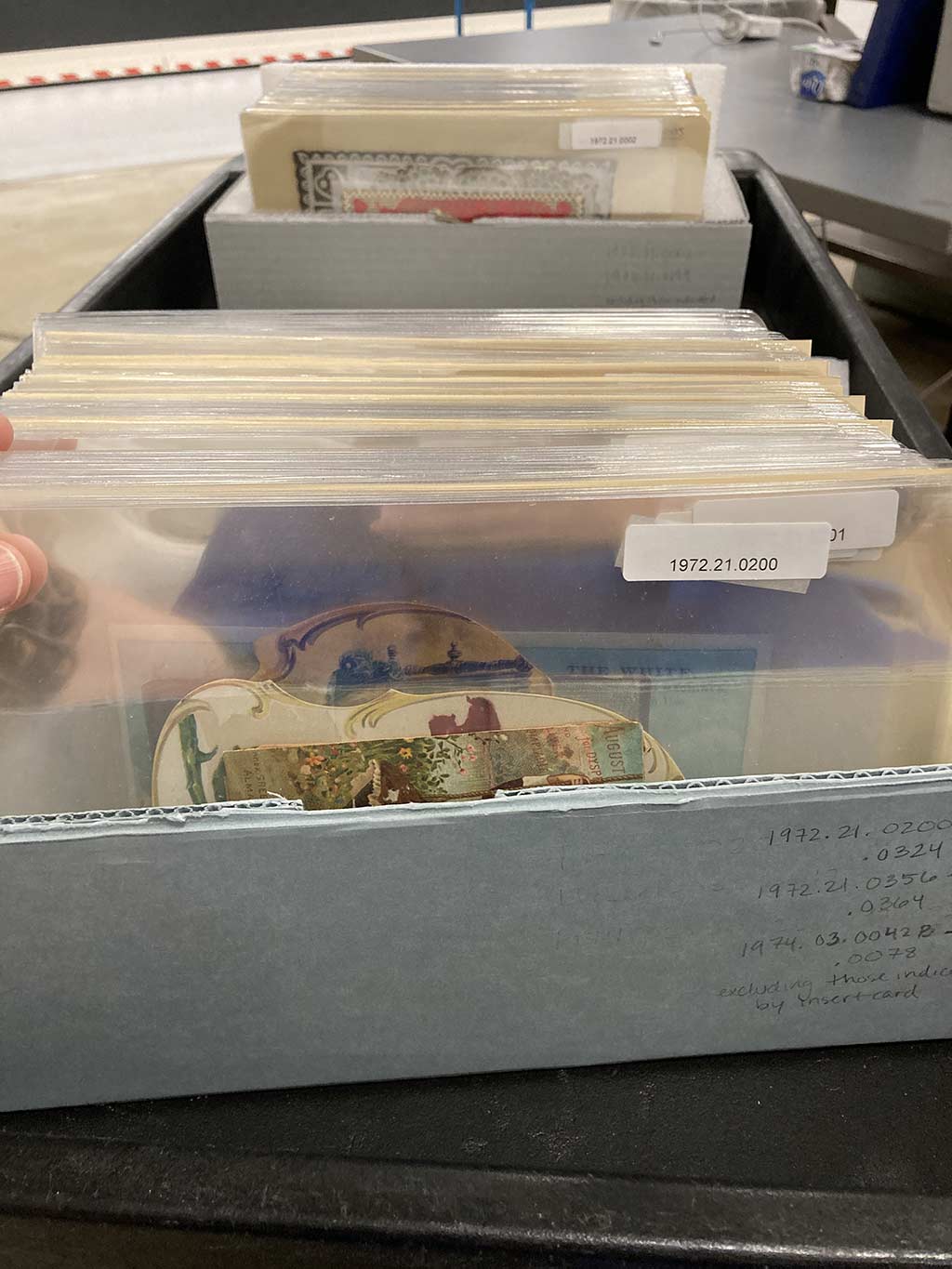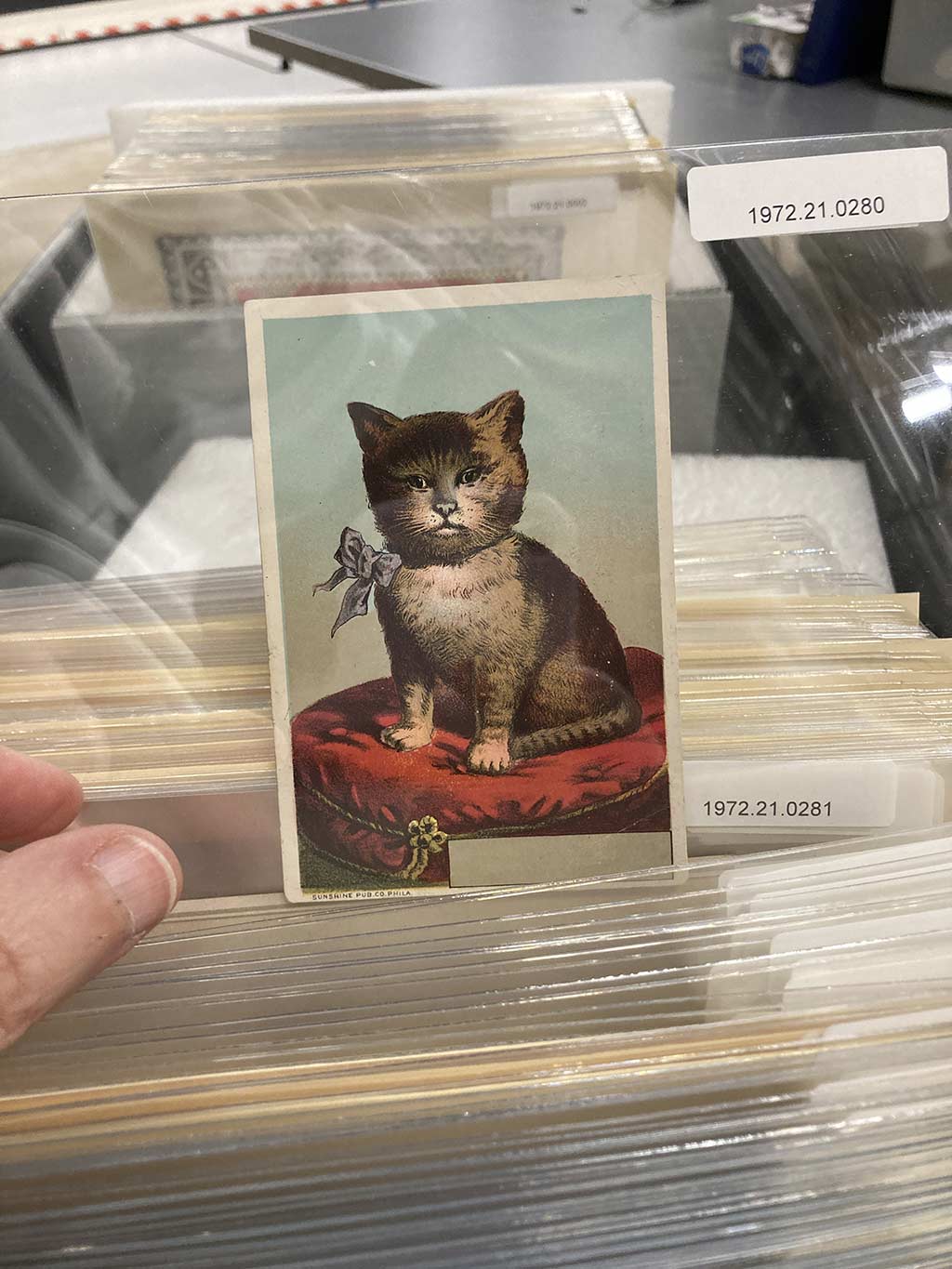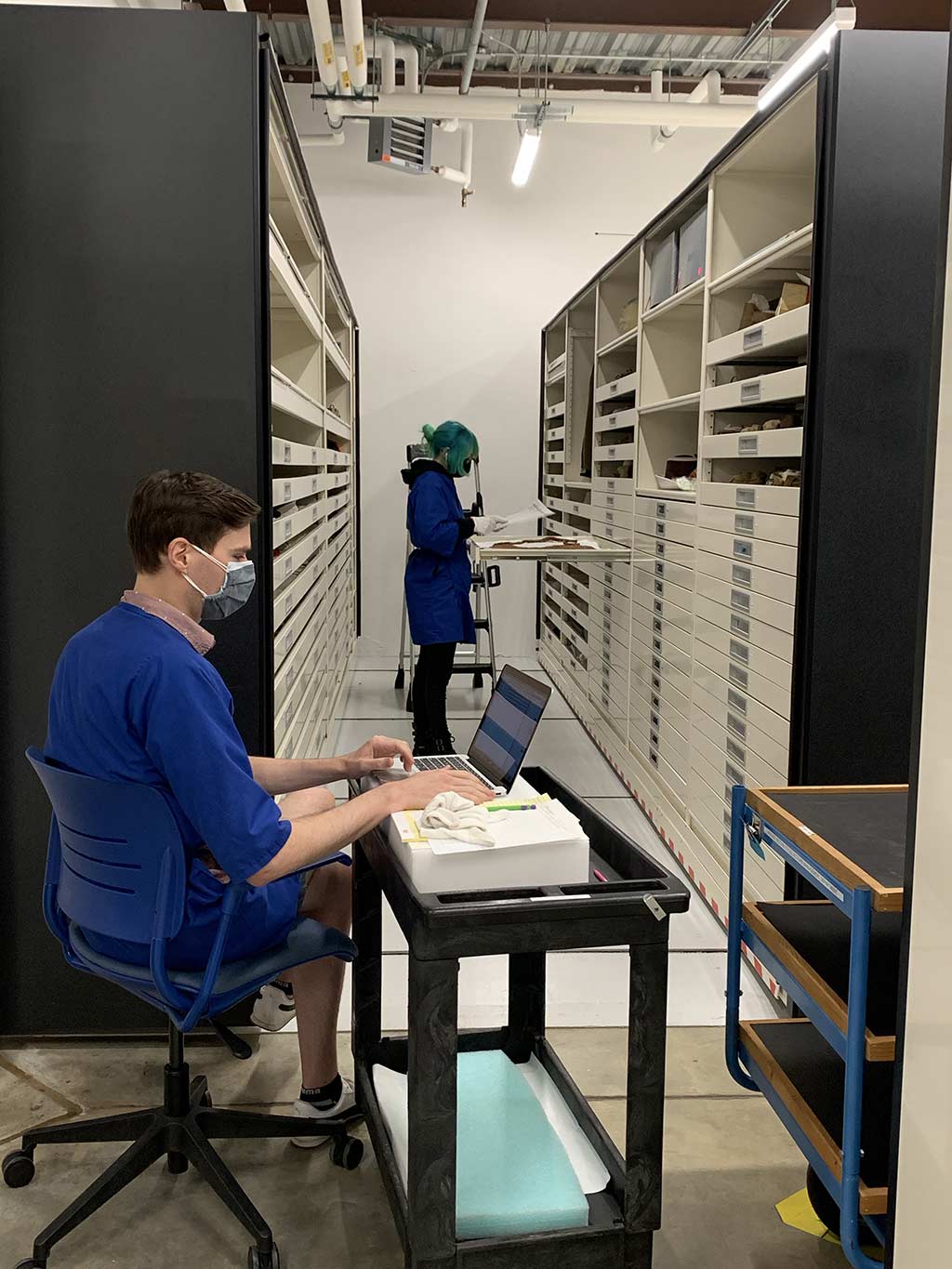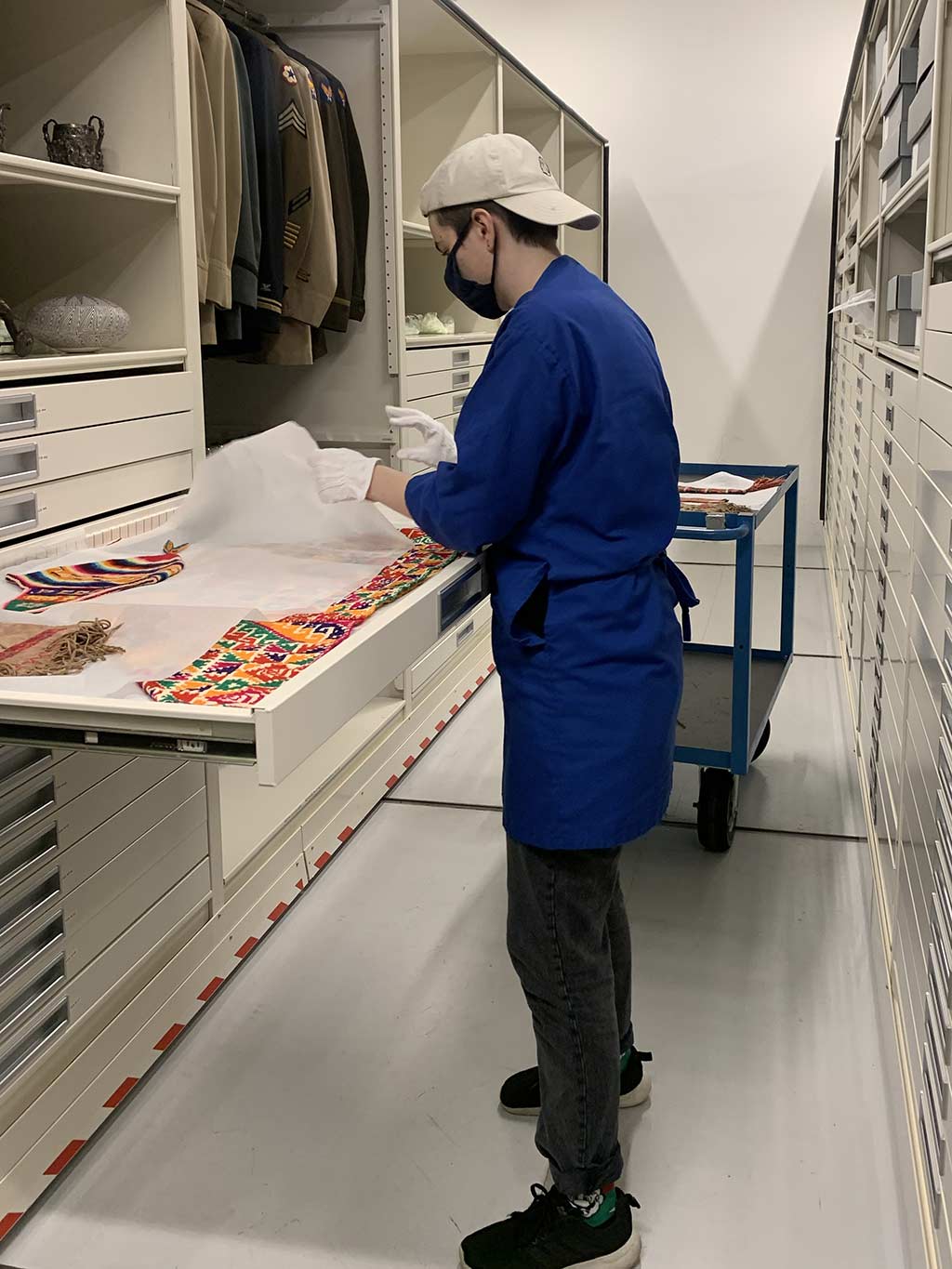
The Story of Inventory
- Post Date: 8/31/2022
- Author: Beth Watkins and Dery Martínez-Bonilla
- Reading Time: 6 minute read
Every 10 years, the museum does a complete inventory of our artifact collection. As we work on this project, we wanted to take a moment to talk about how this difficult aspect of behind-the-scenes work matters to the bigger picture of how the museum functions. I asked Dery Martínez-Bonilla, Assistant Registrar for Acquisitions, who organized the project, to explain.
- [Beth] What does inventory accomplish?
- [Dery] Doing a complete inventory enables us Inventory allows us to properly locate and identify all the items that make up our permanent collection. The process also helps us find items that have been misplaced or have been deemed missing. By setting eyes on everything that we have, we are better able to evaluate and reconsider whether any particular item should be considered for transfer or deaccession. Deaccessioning is not something to take lightly, but if there’s a better home for an item—where it could be better housed, researched, and used for the enrichment of community and University stakeholders—then it’s our responsibility to consider transferring the items to other units on campus. Our mission and goals have changed since many of these items were acquired/accessioned, so transferring items also enables us to make better use of our resources to fulfill our mission.
- Looking at each object and its record also helps us find problems: things that weren’t properly photographed or catalogued in the past and areas where we need to reassess storage and packing. Many of these items have not been looked at since the last inventory almost a decade ago. The physical conditions of artifacts also change over time, so each inventory raises different preservation needs to consider.
Left: Each day, Dery organizes the available staff into work teams of two. Here, Collections Storage Coordinator Gavin Robinson runs the database while Collections student Gillian reports on what is found in the drawer. Dery also makes sure to let people switch off duties so that no one has to stand or sit for too long.
Right: Most students who work at Spurlock will never get to be part of the full inventory process. Collections student and senior Anna Rataj has worked at the museum for 3 years, and we’re grateful to have someone so experienced as part of this big project. Here, Anna lifts tissue paper to check a quechquemitl, a poncho-like garment from Mexico.
- [Beth] Those are goals that staff members appreciate. Can you put inventory into the broader context of how the museum serves the public?
- [Dery] The whole process really helps the museum understand better what we have—and what work we need to do in order to be better stewards of the items we hold. It leads to improving how we exhibit and research our collections. It enables us to assess the accessibility and relevance of collections and realize potential projects we can collaborate on with other units or students.
- [Beth] Why did you think summer 2022 was a good time to undertake this huge project?
- Dery: Like most big projects, we had to think about the available resources, and luckily we actually had them this summer! Time, budget for student staff, and support from colleagues (specifically Collections staff, who are experts at using our storage areas and handling objects). Also, we’re hoping to be re-accredited by the American Alliance of Museums soon, and we wanted to include this accomplishment in our application.
-
 Some objects, like these turn of the century advertising and greeting cards, are already arranged in order by their accession numbers and are easy to cross-check with the database.
Some objects, like these turn of the century advertising and greeting cards, are already arranged in order by their accession numbers and are easy to cross-check with the database. -
 But we still check each one…which leads us to find things like this Victorian greeting card featuring a cat who seems unimpressed with their fancy blue bow.
But we still check each one…which leads us to find things like this Victorian greeting card featuring a cat who seems unimpressed with their fancy blue bow.
- [Beth] Have you faced any maddening mysteries?
- [Dery] So far, we’ve found 15 items that are not documented at all in our records. Most of these seem to be components of other objects that were not labeled as such and have become separated from their parent piece, so to speak. Once once we’re done with inventory, we’ll try to find their accompanying pieces.
- We’ve come across several items that are labeled with a number, and the written descriptions match the piece and its number, but the photos do not. Most of these items came in around the time when the Spurlock opened, so the move across campus (2000) and transition into our new building probably led to some of these mismatched situations.
- As someone whose work often focuses on record-keeping, I’m really excited that we’ve found three objects that were labeled as missing in the last inventory!
- [Beth] What about any fun discoveries?
- [Dery] One of my favorite things is the amount of bells and other ornaments for animals we have in the collection. There is at least one full drawer full of bells from different countries and cultures for water buffalo, goats, cows, camels, and elephants. Some are very simple, and others are very beautifully decorated.
- My other favorite thing is the hupiles (shirts made by Maya weavers in Guatemala). I’ve seen photos of them before, but seeing the variety and vibrancy of the color along with the various motifs is breathtaking. There are some colors I have never seen in my life! It truly is amazing how ornate and meaningful these are. Handling textiles is not my favorite thing, but it makes it worth it when I pull the acid free paper off and find some of the most beautiful textiles I have ever seen. And the best part is I get to touch them—with gloves on, of course! But being so close allows for a better understanding of the imagery and symbols depicted and the intricacy of the weaving.
-
 Kata'l Po'j Guatemala 2007 Credit line: Solola Department 2007.11.0008B One of Dery’s favorite huipiles.
Kata'l Po'j Guatemala 2007 Credit line: Solola Department 2007.11.0008B One of Dery’s favorite huipiles.
- [Beth] I know there’s one other collection that you particularly like: the dolls!
- Dery: It’s true. Our collection of dolls is awesome! They are all so different, some maybe a tad creepy, but it makes them more fun. My favorite part is their costumes. Many were made specifically to highlight traditional costumes from various cultures. Others have religious significance. Seeing the different materials, and symbols is not only fun, but also allows us to find more information about the cultures they come from/made them.
A huge thank you to everyone who has worked on inventory this year!
-
- Share:
- Subscribe to Newletter
- Giving

